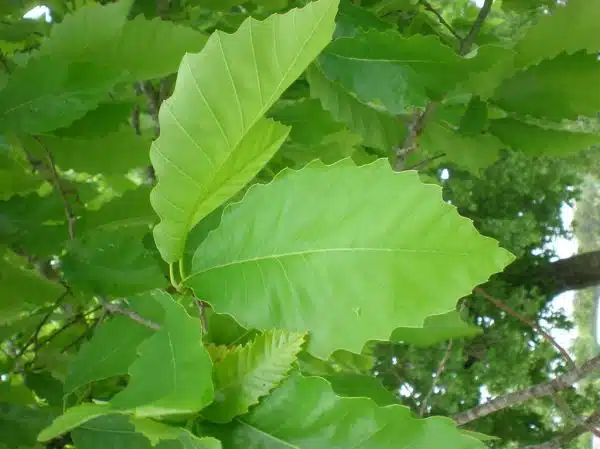Chinkapin oak, also known as Quercus muehlenbergii, is a species of oak tree native to North America. It is a popular choice among homeowners and landscapers due to its attractive appearance and ability to thrive in a variety of soil types. However, like all trees, Chinkapin oak requires proper care and maintenance in order to reach its full potential.
As an arborist or tree care expert, it is important to understand the unique characteristics and needs of the Chinkapin oak. By following proper planting techniques and implementing routine maintenance practices, you can ensure the health and longevity of this beautiful tree. In this article, we will explore the key considerations for growing and caring for Chinkapin oaks, including soil requirements, pruning techniques, and pest management strategies. By implementing these tips and best practices, you can help your clients create healthy and thriving landscapes that will serve them for years to come.
Understanding The Characteristics Of Chinkapin Oak
Amidst the towering trees of North America lies a magnificent species known as Chinkapin Oak. Its scientific name, Quercus muehlenbergii, is derived from a German botanist, Gotthilf Heinrich Ernst Muhlenberg. This species of oak tree is found in the Midwest and eastern regions of North America. It can grow up to 60-80 feet tall with an equal spread, and it has a round or oval-shaped crown.
Chinkapin Oak is characterized by its deeply furrowed bark that forms diamond-shaped ridges. The leaves are simple with a glossy green top surface and pale green underside. They are also toothed and have wavy margins. During autumn, the leaves turn yellow-bronze or yellow-brown color before falling off. The tree’s acorns are small in size and have a fringed cap that covers less than half of the nut.
Identification of Chinkapin Oak can be challenging due to its similarity with other oak species. However, distinguishing features include its deeply furrowed bark, shiny green leaves with wavy margins, and small acorns with fringed caps. It’s also important to note that Chinkapin Oak often grows in well-drained soils such as sandy loams or loamy sands with moderate moisture levels. Understanding these characteristics will enable you to identify this majestic tree quickly and easily when you come across it during your travels through North America’s forests and woodlands.
With proper identification of Chinkapin Oak complete let us now move on to choosing the right location for planting this beautiful tree so that it can thrive for years to come!
Choosing The Right Location For Planting
When choosing the right location for planting a Chinkapin Oak, it is important to consider the amount of sunlight, soil type, drainage, wind protection, climate, moisture, pollution, space, distance from other trees, slope, orientation, water accessibility, size of the plant, root competition, and location. Each of these elements can have an effect on the successful growth and care of a Chinkapin Oak, so it is essential to plan ahead. It is recommended to research the optimal conditions for the species, and to ensure that the chosen planting site is as close as possible to these conditions. Additionally, regular maintenance and care should be provided to the tree in order to achieve the best outcome.
Sunlight
When choosing the right location for planting a chinkapin oak, it is essential to take into consideration the amount of sunlight that the tree will receive. Chinkapin oaks thrive in areas with optimal exposure to sunlight, which is typically at least six hours per day. This is necessary for healthy growth and development, as well as for the production of acorns.
However, it’s important to note that too much sunlight can also be detrimental to the health of chinkapin oaks. In areas with intense heat and sun exposure, these trees may require some shade management to avoid stress or even death. This can be achieved by planting them near other trees or structures that provide shade during peak sun hours.
Overall, providing appropriate sunlight conditions is crucial for the successful growth and care of chinkapin oaks. With proper planning and maintenance, these trees can thrive in a variety of locations and provide both aesthetic beauty and environmental benefits for years to come.
Soil Type
Choosing the right location for planting a chinkapin oak is crucial for its growth and development. Apart from considering the amount of sunlight, it is essential to take into account the soil type. The best pH range for chinkapin oaks is between 6.0 and 7.5, which means that they grow well in slightly acidic to slightly alkaline soils. It is advisable to test the soil before planting to ensure that it falls within this range.
In addition to pH, soil drainage is also crucial for the successful growth of chinkapin oaks. These trees prefer well-drained soils because waterlogged or poorly drained soils can lead to root rot and other diseases. Therefore, it is vital to avoid planting them in areas with heavy clay or compacted soils as they retain moisture for longer periods.
To provide optimal growing conditions for chinkapin oaks, it is best to plant them in loamy soils with good drainage and adequate amounts of organic matter. Incorporating organic matter such as compost or leaf litter when planting can help improve soil structure and fertility. In cases where the existing soil does not meet these requirements, amendments can be made by adding sand or peat moss to improve drainage or increase acidity levels respectively.
In conclusion, choosing the right location for planting a chinkapin oak involves considering various factors such as sunlight exposure, soil pH, and drainage. Understanding these requirements helps ensure that the tree thrives and provides aesthetic beauty and environmental benefits for years to come.
Soil Requirements For Optimal Growth
Chinkapin oaks are adaptable trees that can grow in a variety of soil types. However, they thrive best in well-drained soils that are slightly acidic. The soil should provide adequate moisture and nutrients to support the growth of the tree.
Improving drainage is critical for optimal growth of chinkapin oak trees. The trees require well-draining soils to prevent waterlogging, which can lead to root rot and stunted growth. To improve drainage, amending the soil with organic matter such as compost or peat moss can increase the soil’s ability to hold moisture while allowing excess water to drain away.
Soil testing is an essential step in determining the nutrient content of the soil and whether there are any deficiencies that need correcting. Soil tests will help determine what nutrients are needed and in what quantities. It is recommended to perform a soil test before planting chinkapin oak trees and every three years thereafter to monitor changes in nutrient levels over time. By analyzing the results, arborists can make informed decisions about how much fertilizer to apply and what type of amendments are required for optimal growth.
To maintain healthy chinkapin oak trees, proper soil management is crucial. Improving drainage by amending the soil with organic matter and conducting regular soil tests can ensure that the tree has access to necessary nutrients while preventing waterlogging. In the subsequent section, we will explore watering and fertilization techniques for chinkapin oaks that further support their healthy growth.
Watering And Fertilization Techniques
When watering and fertilizing a chinkapin oak, it is important to consider the frequency, amount, and type of fertilizer used, as well as the timing and type of water being applied. Deep soaking is also important to ensure that the roots of the tree are able to absorb the necessary nutrients. Additionally, organic matter such as compost and mulch can be beneficial to the tree’s health, particularly during drought conditions and periods of low rainfall. Finally, it is essential to test and adjust the pH balance and type of soil around the tree to ensure optimal growth.
Watering
As arborists, we understand the importance of watering trees, especially young ones like the chinkapin oak. Watering is a crucial aspect of tree care that cannot be overlooked. In fact, proper watering techniques can help to ensure the healthy growth and development of your chinkapin oak.
When it comes to watering your chinkapin oak, there are a few key factors to consider. First, it’s important to water your tree frequently but not too much. Overwatering can cause root rot and other problems that can harm your tree’s health. Generally speaking, aim to water your chinkapin oak once or twice per week during the growing season.
To determine how much water your chinkapin oak needs, consider its size and environmental conditions. If you live in an area with high temperatures and low humidity levels, for example, you may need to water more frequently than if you live in a cooler climate with higher humidity levels. Additionally, you may want to consider using irrigation methods such as drip hoses or soaker hoses to ensure that water gets deep into the soil where your tree’s roots can access it easily. By following these guidelines and monitoring your tree’s response carefully, you can help ensure that your chinkapin oak thrives for years to come without any issues related to dehydration or inadequate irrigation.
Fertilization
As professional arborists, we understand the importance of proper tree care, including adequate watering and fertilization. While watering is crucial to a tree’s growth and development, fertilization can also play a significant role in ensuring that your chinkapin oak thrives. Using organic or synthetic fertilizers can provide essential nutrients that your tree may not receive naturally in its environment.
When it comes to fertilizing your chinkapin oak, timing and frequency are critical factors to consider. Generally speaking, it’s best to apply fertilizer in early spring before new growth begins. This allows the nutrients to be absorbed readily by the roots as they emerge from winter dormancy. Additionally, fertilizing once every year or two may be sufficient for a healthy mature tree. However, young trees may require more frequent applications during their early years of growth.
Using organic fertilizers can be an effective way to nourish your chinkapin oak without introducing harmful chemicals into the ecosystem. Organic options such as composted manure or bone meal can provide slow-release nutrients over time, allowing your tree to absorb them gradually as needed. Synthetic fertilizers can also be useful but should be used sparingly and in moderation to avoid over-fertilization issues that could harm your tree’s health. By following these guidelines and monitoring your tree’s response carefully, you can promote optimal growth and health for your chinkapin oak.
Pruning For Healthy Branch Development
Proper watering and fertilization techniques are essential for healthy chinkapin oak growth. However, pruning is equally important in maintaining the tree’s health and appearance. Pruning techniques aim to enhance branch structure, prevent damage, and remove diseased or dying branches.
When it comes to pruning chinkapin oak trees, timing is everything. It is best to prune during the dormant season, either in late fall or winter when the tree is not actively growing. This ensures that the tree has enough energy to heal any wounds caused by pruning before new growth begins in spring. Additionally, it is crucial to use sharp and clean tools to prevent tearing or damaging the bark.
One of the primary goals of pruning chinkapin oaks is to promote healthy branch development. Proper pruning techniques can help maintain a strong central leader trunk while allowing adequate space for lateral branches to grow outwards. This creates a sturdy and balanced canopy that can withstand harsh weather conditions and heavy wind loads. Furthermore, by removing any diseased or damaged branches promptly, you can prevent pests from infesting your tree and causing further harm.
In managing insects and diseases that may affect chinkapin oaks, prevention is key. A well-maintained tree with good cultural practices such as proper watering and pruning will have a better chance of avoiding pest problems. However, sometimes even the best preventive measures fail, and you may notice signs of pests or diseases on your tree. In such cases, it is crucial to identify the problem early on so that appropriate measures can be taken swiftly to prevent further damage or spread of disease.
Managing Insects And Diseases
Back in the day, managing insects and diseases was a daunting task for tree lovers. However, with the advancements in technology, it is now easier to prevent infestations and treat fungal infections. Chinkapin oaks are not immune to pests and diseases, but with proper care, they can withstand these challenges.
Preventing infestations is an essential step in maintaining your chinkapin oak’s health. Regularly inspect the tree for signs of pests such as borers, scale insects, and leaf miners. You can also spray insecticides to ward off any potential threats. Additionally, pruning weak or damaged branches can help reduce the risk of insect infestation.
Like other trees, chinkapin oaks are prone to fungal infections such as oak wilt and powdery mildew. If left untreated, these infections can cause significant damage to your tree. To prevent fungal infections from spreading to healthy parts of the tree, remove any infected branches or leaves promptly. You can also apply fungicides during periods of high humidity or wet weather.
To keep your chinkapin oak healthy and thriving, it is crucial to take good care of its roots by mulching for moisture retention. Mulching provides a layer of insulation around the roots that helps retain moisture while also regulating soil temperature. This process reduces stress on the tree during harsh weather conditions such as droughts or heatwaves. Therefore, applying a layer of organic mulch around your chinkapin oak’s base will keep it healthy and nourished for years to come.
Mulching For Moisture Retention
Mulching can be an effective way to help conserve soil moisture, reduce weeds, and protect soil from erosion. The advantages of mulching include enhancing soil fertility, regulating soil temperatures, and reducing the need for frequent irrigation. Various types of mulch are available, such as organic products like bark, straw, and pine needles, as well as inorganic options like gravel and plastic. Inorganic mulches can offer better weed control and heat retention, while organic mulches offer more nutrition for the soil.
Advantages Of Mulching
Mulching is an essential technique for maintaining the moisture level around the chinkapin oak tree. One of the benefits of mulching is that it conserves soil moisture by reducing water evaporation from the soil surface. This helps to ensure that the chinkapin oak has enough water available to thrive and grow during times of drought or water scarcity.
Another advantage of mulching is that it helps to regulate soil temperature around the root zone of the chinkapin oak. Mulch acts as a thermal blanket, keeping the soil cooler in hot weather and warmer in cold weather. This stabilizes the temperature around the roots, which can help prevent damage from temperature fluctuations and promote healthy root growth.
In addition, mulch also provides several other benefits for chinkapin oak care, such as suppressing weed growth, improving soil structure, and enhancing nutrient availability. Therefore, it is recommended to regularly mulch around your chinkapin oak tree to ensure its health and longevity. By using appropriate techniques and selecting suitable materials for mulching, you can help your tree thrive while minimizing maintenance efforts.
Types Of Mulch
To further discuss the benefits of mulching, it is important to consider the different types of organic mulch available. One type of organic mulch is wood chips, which are a popular option for many tree care professionals. Wood chips are readily available and provide excellent moisture retention and temperature regulation benefits. Another type of organic mulch is shredded leaves, which can be easily obtained by raking leaves during the fall season. Shredded leaves also offer similar benefits as wood chips, but may break down more quickly over time.
A third type of organic mulch is compost, which is made from decomposed plant material and provides a rich source of nutrients for the chinkapin oak tree. Compost has the added benefit of improving soil structure and enhancing soil fertility. Lastly, straw or hay can also be used as mulch around chinkapin oak trees. Although not as effective in retaining moisture, straw or hay can help suppress weed growth while still providing some temperature regulation benefits.
When selecting a type of organic mulch to use around your chinkapin oak tree, it’s important to consider its availability, cost-effectiveness, and effectiveness in retaining moisture and regulating soil temperature. It’s also important to apply the appropriate depth of mulch (usually 2-4 inches) to ensure maximum benefits without smothering the root zone. By using suitable materials for mulching based on your specific needs and circumstances, you can help ensure that your chinkapin oak tree remains healthy and vibrant for years to come.
Understanding The Growth Cycle Of Chinkapin Oak
As an arborist or tree care expert, it is important to understand the growth cycle of chinkapin oak trees. These trees grow best in well-draining soil and require full sun for optimal growth. The chinkapin oak is a deciduous tree, meaning that it loses its leaves each fall before new ones grow again in the spring.
Understanding seasonal changes is essential for proper care of the chinkapin oak. In the spring, these trees produce small flowers that develop into acorns in the fall. During this time, it is crucial to provide adequate water and fertilizer to promote healthy growth. In summer, pruning for optimal growth can be done by removing any dead or damaged branches and shaping the tree as desired.
In autumn, the chinkapin oak’s leaves will turn a golden brown color before falling off in preparation for winter dormancy. During this time, it is important to protect the tree from harsh winds and cold temperatures by mulching around its base. Understanding these seasonal changes will aid in providing optimal care for your chinkapin oak tree.
Moving forward, identifying common issues and solutions can help maintain a healthy and vibrant chinkapin oak tree.
Identifying Common Issues And Solutions
Common pests and nutrient deficiencies are obstacles that gardeners may encounter when growing chinkapin oak. Common pests include the gall wasp, which causes the formation of galls on leaves, twigs, and branches. These can weaken the tree and make it more susceptible to other diseases. Pests such as borers and scale insects may also attack the tree’s trunk and limbs, causing damage to its structure.
Nutrient deficiencies may also be an issue for chinkapin oak. Symptoms of nutrient deficiencies include yellowing leaves or stunted growth. Soil testing is recommended to determine if the soil is lacking in any essential nutrients. If a deficiency is found, fertilization can help correct the problem. However, over-fertilizing can also harm the tree, so it is important to follow recommended dosages.
To prevent common pests and nutrient deficiencies, proper care must be given to chinkapin oak trees. Adequate watering should be provided during dry periods, but overwatering should be avoided as it can lead to root rot. Pruning should also be done regularly to remove dead or diseased branches that could attract pests or cause nutrient imbalances within the tree. Observing these practices will keep your chinkapin oak healthy and thriving for years to come.
As with any plant species, propagation techniques are essential knowledge for those looking to grow chinkapin oak trees successfully. Propagation can be done through seed germination or by taking cuttings from an established tree. Each method has its own unique set of challenges and requirements for success. Understanding these techniques will allow you to propagate new trees effectively while ensuring genetic diversity within your planting area.
Propagation Techniques For Chinkapin Oak
One of the most effective propagation techniques for chinkapin oak is grafting. This method involves taking a cutting from a healthy mature tree and attaching it to a rootstock of another species. The rootstock provides the young graft with necessary nutrients while also providing disease resistance and growth promotion. Grafting has been used for centuries in horticulture and forestry, and it remains an excellent method for propagating chinkapin oak trees.
Another successful propagation method for chinkapin oak is seed collection. The best time to collect seeds is in the fall when they have ripened on the tree. Seeds can be collected by hand or by placing a tarp under the tree and shaking branches to release them. Once collected, seeds should be stored in a cool, dry place until planting season arrives. It’s important to note that chinkapin oaks do not produce many seeds, so this method may not be as reliable as others.
When deciding on a propagation method for your chinkapin oak trees, consider your location and resources. Grafting requires specialized equipment and expertise, making it less accessible for novice growers. Seed collection is simpler but may not yield as many results. Regardless of which method you choose, patience and persistence are key when propagating trees.
Transition: Now that you’ve learned about propagation techniques for chinkapin oak, let’s discuss how to care for these trees during the winter months to ensure their survival through harsh weather conditions.
Winter Care And Protection
After successfully propagating your Chinkapin Oak, it is important to care for it during the winter months. Protective coverings can be used to shield the tree from harsh winter weather. Burlap or other breathable fabrics can be wrapped around the trunk and branches to prevent damage from ice, snow, and wind. Be sure to secure the covering in place with twine or rope, but not so tightly that it restricts growth.
Additionally, providing adequate winter watering is crucial for maintaining the health of your Chinkapin Oak. Even though the tree may be dormant during this time, it still requires water to survive. However, do not water if there is still moisture in the soil as this can lead to root rot. It is best to water during periods of dry weather when temperatures are above freezing.
In order to ensure a successful harvest of Chinkapin Oak acorns, proper care and attention must be given throughout the growing season. Trees should be pruned regularly to promote healthy growth and acorn production. Once acorns have fallen from the tree, they can be harvested by hand or with a rake. Acorns should then be stored in a cool, dry place until ready for use in planting or consumption. With proper care and attention, your Chinkapin Oak will continue to thrive year after year.
Harvesting And Utilizing Chinkapin Oak Acorns
As an arborist or tree care expert, it is important to not only know how to grow and care for a chinkapin oak tree but also how to utilize its resources. One of the most significant resources of the chinkapin oak is its acorns. These nuts are an essential food source for wildlife such as deer, squirrels, and turkeys. But with proper harvesting techniques, humans can also benefit from this nutritious nut.
Harvesting chinkapin oak acorns can be a fun and rewarding experience. As the tree begins to shed its acorns in autumn, gather them up from the ground before they are consumed by hungry critters. Once collected, separate out any damaged, moldy or insect-infested acorns. Roasting the acorns in an oven or over a fire can remove any bitterness and enhance their flavor. After roasting, you can grind the nuts into flour using a food processor or mortar and pestle. This flour can then be used as a gluten-free alternative in baking recipes such as cookies or bread.
Acorn flour recipes have been used for centuries by Native Americans and other cultures around the world. The use of chinkapin oak acorn flour has many benefits including being high in protein, fiber, and healthy fats while low in carbohydrates. The nutty flavor makes it an excellent addition to savory dishes like soups or stews as well as sweet treats like pancakes or muffins.
Incorporating chinkapin oak acorns into your diet is just one way to utilize this incredible tree species. In addition to its edible resources, it also provides shade and beauty when used in landscaping designs. In the next section, we will explore how planting a chinkapin oak tree in your yard can provide not only aesthetic value but also environmental benefits such as carbon sequestration and improved air quality.
Using Chinkapin Oak In Landscaping Designs
Chinkapin oak has a unique appearance that can be incorporated into various hardscaping designs. Its distinctive bark and leaves make it an attractive choice for landscaping. When using chinkapin oak in hardscaping designs, it is essential to ensure that the tree’s growth is taken into consideration. This will prevent the tree from causing damage to any structures close to it.
In addition to its aesthetic appeal, chinkapin oak is also an excellent choice for creating wildlife habitats. The acorns produced by the tree are a valuable source of food for many animals, including squirrels and deer. The tree’s dense canopy also provides shelter for birds and small mammals. Incorporating chinkapin oak into wildlife habitats is a great way to attract and support diverse animal species in your backyard.
Overall, chinkapin oak is an excellent choice for landscaping and can be used in a variety of ways. Whether you’re designing hardscapes or creating wildlife habitats, this tree has something unique to offer. By partnering with clients to understand their needs and preferences, arborists can help them incorporate chinkapin oak into their landscapes successfully. With proper care and attention, these trees can thrive for years to come, providing numerous benefits to both humans and animals alike.
Partnering With Clients For Successful Tree Care
Effective communication is an essential part of successful tree care in order to understand the client’s goals, budget and expectations. Building trust through regular inspections and proper pruning, as well as ensuring soil health and proper fertilizing, mulching, and watering are important components of successful tree care. In addition, regular monitoring of growth and assessment of needs for disease prevention and pest control is crucial for successful tree care. Partnering with clients for successful tree care requires a comprehensive approach that includes effective communication, goal-setting, understanding budgets, setting expectations, building trust, regular inspections, proper pruning, soil health, fertilizing, mulching, watering, disease prevention, pest control, monitoring growth, and assessing needs.
Communication
To successfully care for chinkapin oak, it is important to establish an effective communication strategy with the client. Good communication ensures that the tree care expert fully understands the client’s needs and expectations. It also allows for a transparent exchange of information, preventing any misunderstandings or miscommunications.
Improving communication can be achieved by actively listening to the client’s concerns and questions. Arborists must patiently address their queries, providing clear and concise answers. Additionally, establishing open lines of communication through regular updates on the progress of the tree care project helps build trust between the client and arborist.
Effective communication strategies include using layman terms when discussing technical aspects of tree care. Arborists should avoid using jargon or overly complex language that could confuse clients. Clear written and verbal instructions should also be provided to ensure that clients understand what work is being done on their property. By implementing these strategies, arborists can enhance their communication skills, leading to successful partnerships with clients for chinkapin oak care.
Establishing Goals
As an arborist, partnering with clients for successful tree care involves various aspects. One of the crucial elements is setting objectives and tracking them. In this step, it is essential to establish clear goals that align with the client’s needs and expectations. Arborists should work with their clients to identify specific objectives for the tree care project, such as improving the health of a chinkapin oak or enhancing its aesthetic appeal.
Once the objectives are identified, goal tracking becomes important to ensure that progress is being made towards achieving them. This involves monitoring the tree’s growth, identifying any potential issues that may arise during the project, and making necessary adjustments along the way. By tracking goals regularly and providing updates to clients on progress, arborists can build a transparent relationship with their clients, fostering trust and confidence in their work.
Additionally, establishing realistic timelines for achieving goals is crucial when partnering with clients for successful tree care. Arborists should communicate clearly about how long each step of the project will take and set realistic deadlines for completing each objective. This helps manage client expectations and ensures that all parties involved are working towards a common goal. By closely collaborating with clients throughout each stage of the process, arborists can achieve optimal results for chinkapin oak care while building strong partnerships based on clear communication and achievable goals.
Resources For Continued Learning And Growth
One of the best ways to continue learning about growing and caring for chinkapin oak trees is by taking online courses. These courses can provide in-depth knowledge on various aspects of tree care, including soil health, pruning techniques, pest management, and more. By enrolling in these courses, you can learn from experienced arborists and gain valuable insights that will help you grow healthy chinkapin oak trees.
Expert consultations are another great resource for continued learning and growth when it comes to caring for chinkapin oaks. Arborists with years of experience in the field can provide personalized advice on how to care for your specific tree. They can also help you identify any issues that may be affecting your tree’s health and provide solutions to address them. This type of consultation is especially useful if you’re facing a specific challenge or want to ensure that your tree remains healthy and vibrant for years to come.
In addition to online courses and expert consultations, there are plenty of other resources available to help you expand your knowledge on chinkapin oak care. Books and publications written by experts in the field can provide valuable insights into everything from soil management to pest control. You can also attend workshops or conferences focused on arboriculture to learn about new trends or techniques in the industry. By taking advantage of these resources, you can continue growing as an arborist and provide better care for your chinkapin oak trees.
| Resource | Benefits | Limitations |
|---|---|---|
| Online Courses | Flexible scheduling allows learners around-the-clock access; Wide range of topics covered | Limited interaction with instructors; May lack hands-on experience |
| Expert Consultations | Personalized advice tailored specifically to your tree; Opportunity for hands-on learning | Cost may be prohibitive; Scheduling conflicts may arise |
| Books & Publications | In-depth information provided by experts in the field; Accessible at any time | Information may become outdated; Limited interaction with content |
With so many resources available, there’s no excuse for failing to continue learning about chinkapin oak care. By staying up-to-date on the latest techniques and best practices, you can ensure that your trees remain healthy and vibrant for years to come. Whether you choose to enroll in online courses, seek out expert consultations, or explore other resources, taking the time to expand your knowledge will pay off in the long run.
Conclusion
The chinkapin oak is a beautiful and resilient tree that can thrive in a variety of conditions. As an arborist, it is crucial to understand the characteristics of this species and select the right location for planting. Proper soil requirements, watering techniques, and pruning practices are also essential for healthy growth and development.
It is important to note that caring for chinkapin oaks requires dedication and attention to detail. However, with proper care and maintenance, these trees can provide a wealth of benefits to both homeowners and communities alike. As the saying goes, “you reap what you sow,” and this rings true when it comes to nurturing chinkapin oaks.
In addition to providing shade and aesthetic value, chinkapin oaks offer ecological benefits such as wildlife habitat and air purification. By partnering with clients for successful tree care, arborists can help promote the longevity of these precious resources. With continued learning and growth through resources such as professional organizations or peer collaboration, arborists can enhance their skills in caring for chinkapin oaks and other tree species.
Image Credits
- “Chinkapin Oak” by Mary Tricia (featured)





























